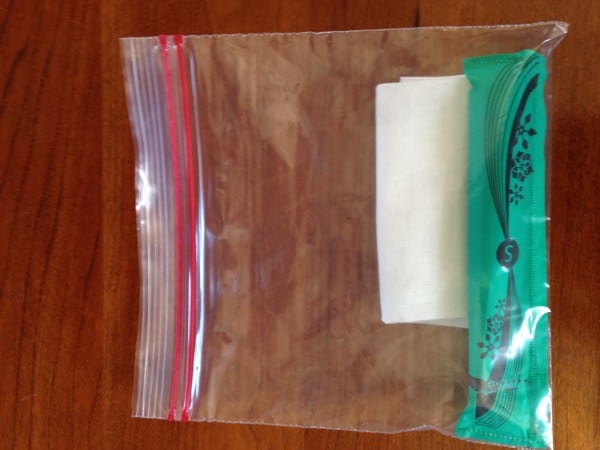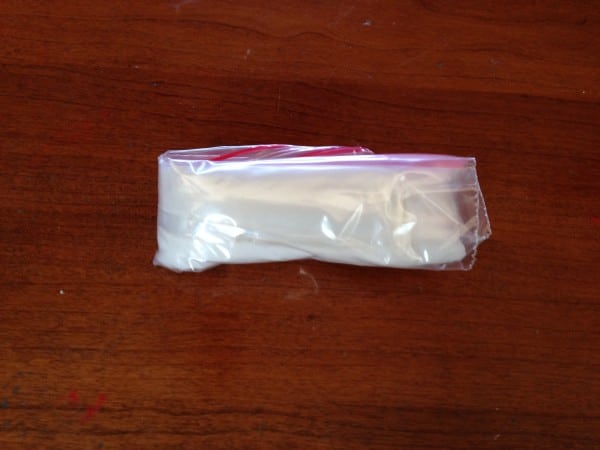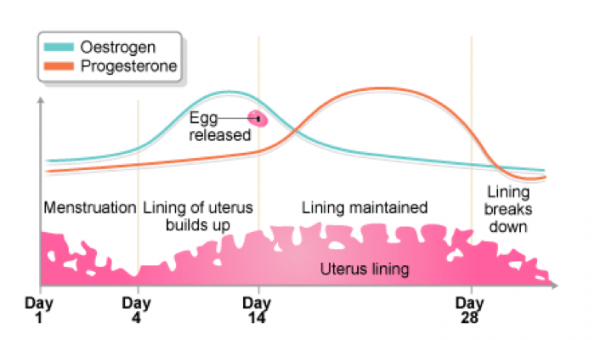From Liza:
Well, actually, it is. We were going to wait to talk about this until we’d all been friends longer, but I spent the day after the recent Rocky Racoon 50 Mile picking up trash on the trail–including sanitary napkins, so the time seemed ripe (so to speak.)

A used sanitary napkin left just off the trail at the Rocky Racoon 50 Mile this year. Photo: Liza Howard
Now before all you non-menstruators bail, three things:
- We’ll only share the highly useful stuff.
- It never pays to withhold information from yourself.
- All the cool guys will read the whole article.
So when I reached the 50-mile turnaround of the Leadville 100 Mile in 2012, there was a guy waiting there for me, holding a tampon in his outstretched hand. “Here you go!” he said enthusiastically, and handed the tampon to me like he was passing off a relay baton. Now, I did, in fact, need a tampon at that moment, and I had spent the entire run off Hope Pass worrying about toxic shock syndrome. So I was happy to see it, but I felt very awkward and confused accepting a tampon from a complete stranger.
“Thanks… guy.”
I grabbed it and headed back up the road–too embarrassed to run straight into a port-o-potty. I briefly thought about catching the runner in front of me and continuing the relay. (“STICK!”)
Finally I got to some cover, took care of business, and then:
- Left the used tampon in the ground where trash belongs,
- Threw the used tampon into the woods because it’s biodegradable,
- Wrapped it in a wet wipe, put it in a plastic bag, and put the plastic bag in a pocket on my vest, or
- Wondered what the lead male runners were doing right now and shook my fist at the sky.
Guesses, Gina and Pam?
From Gina:
I’ll go with C. I can’t quite picture you leaving it behind… but then again taking the rag for the ride doesn’t sound super appealing.
From Liza:
Indeed, yes, I “took the rag for the ride.” (Good lord, Gina! I’m not going to be able to get that phrase out of my head now.) Leaving used tampons or sanitary napkins somewhere visible ranks high on the list of “Things You Can Do To Negatively Impact Someone’s Run/Life.” Don’t do that to somebody. I still frown and want to wash my hands thinking about the sanitary napkins and toilet paper visible from the trail at Rocky. And remember, the secluded spot or cover you found to take care of yourself will likely be found by every other woman passing–and animals.
From Gina:
Tampons aren’t really biodegradable. Most are made of rayon or cotton which takes a super long time to break down, hence, why you aren’t supposed to flush them! Therefore, leaving them on the trail, or burying them in a hole is pretty harmful to our playground. Plus it is a total eyesore. If you know your period is coming, or you have it… just suck it up and bring a Ziploc to carry it out. Mother Nature and your fellow runners will appreciate it!
From Liza:
And when I don’t care about Mother Nature or my fellow runners late in a race–when my environmental ethics and hygiene take a backseat to exhaustion and self-pity–I keep myself in line by imagining what the trail would look like if all the racers did what I was thinking about doing. If Rocky Racoon 100 Mile’s 350-plus runners all left sanitary products or toilet paper on the 20-mile loop course… “Okay! Fine, I’ll take out the dang Ziploc!!” That’s the standard, and it’s easy enough.
Before your event, put your tampon or sanitary napkin in a Ziploc bag with three wet wipes. (You can make the package smaller by using a tampon that doesn’t have an applicator.)

A packaged tampon and wet wipes ready for use on the trail. Photo: Liza Howard
Use one wet wipe for wiping, one for cleaning your hands, and one to wrap everything up in. Then put it all back in the Ziploc and put it in a pocket.

How to carry a used tampon off the trail and to a garbage can. Photo: Liza Howard
Feel free to shake your fist at the sky afterwards, though.

Scarlett O’Hara shakes her fist in Gone with the Wind. Photo is a screenshot from the film.
From Gina:
Ironically, I’ve never run into that situation. I haven’t done too many races where I’ve been out long enough to switch it up, and for the ones I’ve had a period for… it has been light enough that I didn’t have the need to change anything.
From Liza:
Well, it’s something to look forward to, then. There was one year, I think I had my period for every race I ran. I’d just dedicate a pocket in my hydration pack a to the Ziploc bag and its contents. I could have fit it into my shorts pocket, too. I’ve never timed myself (because that would be really really weird), but I can’t imagine stowing the used supplies neatly in a Ziploc bag adds more than a handful of seconds to the time it takes to do things in an actual bathroom. Sure, sure, throwing it all on the ground would be fastest, but seven seconds aren’t going to affect your UltraSignup ranking. After Leadville, I just ran with the gear in the pocket of my hydration vest from the race start. No more awkward aid station handoffs and no more agonizing about potential Toxic Shock Syndrome.
From Pam:
Oh yeah, I’ve definitely been in races wondering about toxic shock syndrome (TSS)! Fortunately, TSS is rare. TSS became a health crisis in the late ’70s and early ’80s with the introduction of superabsorbent tampons. This is recent enough for a lot of women to still have fear about this issue, though there are currently only around 50 cases per year (as opposed to 771 tampon-related cases of TSS in 1980). So I don’t think women need to live in dread fear of TSS, but some standard precautions should be followed. Never wear a tampon longer than eight hours and use the least-absorbent model necessary. Pads can be worn longer than eight hours and have not been associated with TSS, but they are certainly not as comfortable to run in.
From Gina:
There is another alternative, The Diva Cup. It is a medical-grade silicone menstrual cup that can be left in for 12 hours, emptied, and then reused. I don’t have any experience with this, but wanted to note that it is another option for women who don’t want to carry a tampon.
From Liza:
So menstruation has a fairly small logistical impact on racing and training. But have either of you noticed how hormonal levels affect your performance? And what about training? I’ve never analyzed my training or racing through the lens of menstrual-cycle hormones, which seems foolish. Pam, you’re the doctor; what do you know?
From Pam:
Well, I’ll try to make this a little better than that lesson you got in fifth grade. And I’ll keep it brief and try to make it pertinent to running! The menstrual cycle is typically 28 days, with a range from about 26 to 35 days. Day 1 is the first day of menstruation (bleeding). Starting around Day 5 estrogen levels begin to rise with a peak right before ovulation (Day 14); this is called the follicular phase. (The follicle, or egg, is getting ready for release during this phase.) After ovulation, estrogen levels fall while progesterone levels rise in anticipation of possible pregnancy (it creates a “pro-gestational” environment, hence the name); this is the luteal phase. If no pregnancy occurs, progesterone levels fall and the uterine lining is once again sloughed.

Screenshot of chart at: https://www.bbc.co.uk/schools/gcsebitesize/science/aqa_pre_2011/human/hormonesrev3.shtml.
Okay, now that we’ve covered the basics, we can get into how these hormonal changes can affect your running. Estrogen facilitates fat utilization, but makes it harder to use glucose. This is works well for endurance workouts or racing ultras. Estrogen does, however, cause a decrease in plasma volume (up to 4%!), which is often why women feel lean or light at this time of the month. It does mean that you have less fluid reserves during this time. Progesterone facilitates glucose utilization. This means glucose is more readily available for the body’s use. This is a good time to schedule speed workouts. Because the body is less inclined to store glucose during this phase, you may need to eat more carbohydrates if you are trying to carb load. Progesterone also increases body temperature (gotta’ keep a newly fertilized egg warm!) and the temperature at which you start to sweat. Additionally, progesterone increases respiration and oxygen consumption, so you may feel like you are working harder during this phase. But many of these changes are subtle enough to not be noticed by most women. What women do notice is the rapid fall in progesterone at the end of the cycle. Mid-cycle, when estrogen falls, it is offset by the rising progesterone, but when progesterone falls, there is no sex-hormone counterbalance, leading to the dreaded “PMS” symptoms. Some of these symptoms, such as headache and bloating, can be attributed to shifting fluid volume. Progesterone increases the plasma volume, but when it falls, the body takes time to adjust. Redistributing the water causes bloating and many women feel heavy or sluggish during this time. There is also a loss of glucose availability that the body has to accommodate. I know personally, my running suffers the most two to three days before my period. Of course, it is usually not until I start my period that I realize why all my workouts have been so terrible the last couple days!
While dealing with your period can be a nuisance, Western States champion Annette Bednosky helped me find a more positive spin for this time of the month. Unfortunately, Christian and Jewish cultures have traditionally branded women as ‘unclean’ or even dangerous during their time of the month. But many Native American and African cultures attribute great power and spiritual ability during their periods. Indeed, bloating usually starts to abate right about the time bleeding begins and by Day 2, estrogen and progesterone are both low and fairly equal–a hormonal situation which is actually great for ‘powerful’ athletic performance. Uta Pipig’s 1996 Boston Marathon win and Paula Radcliffe’s 2002 Chicago Marathon course record occurred during their periods. (Certainly there are more major wins, but women often don’t make this known publicaly).
Of course, just because your hormone situation is good for athletic performance during your period doesn’t mean there aren’t other challenges, especially during ultras which may span many hours or even days. You still may be dealing with lingering PMS and bloating, headaches, cramps and of course, bleeding!
From Gina:
Wowsa’! Thanks for the breakdown, Doc! Is it bad that I didn’t really know half of that info… until now?
My body seems to have a mind of its own and plans its own schedule which is never on a cycle. The only way I know ‘it’s time’ is when my legs are sluggish, my body feels rotund, and Justin reminds me that I’m being an “emotional snapper” (to put it nicely).
My motivation to train during this week-ish-long timeframe leading up to my period is pretty absent. Last thing I want to do is be reminded of how slow I feel when trying to run uphill, and how much water I’m retaining because my spandex tights are now two sizes too small. But this is life.
The advice I have for training through your period is to think of it as if you were training in inclement weather. Sure, most of us want to race on a perfect sunny day in warm temps, but not all events are granted those conditions. So we train through the rainy, snowy, windy, and muddy days to prepare. Training through period symptoms is the same. If you can master how to get through it in training, you won’t have to worry about it come race day.
From Liza:
I like that analogy, Gina. I’m going to start adding tornado and hurricane icons to my training plans from here on out. I hope folks find this article useful. I can’t believe how we got through the whole thing with so few puns.
(PS. Good job, cool guys, if you’re still here!)
[Authors’ Note: Multiple-time USA Team member (100k and 24 hours!) Carolyn Smith, MD and Jason Karp, PhD have written an excellent book called Running for Women. We used it as a resource for this article and recommend it to anyone else who would like more information on this subject and other women’s specific topics.]
Call for Comments (from Meghan)
- How do you manage transporting tampons and the like on long trail runs and races? What is your system?
- Do you notice that your menstrual cycle affects your running in a noticeable way? Can you describe it?
